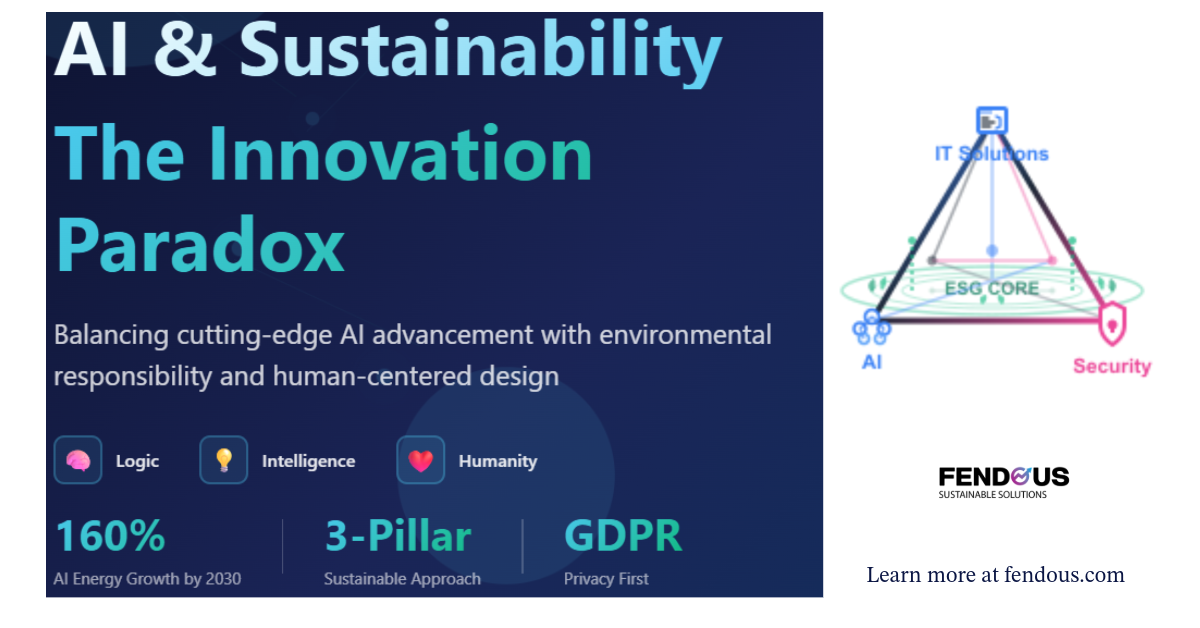AI & Sustainability: Navigating the Paradox of Progress

The Double-Edged Sword of AI Innovation
As AI transforms industries at an unprecedented speed, we face a critical question: Can we innovate responsibly without compromising our planet's future?
The global AI market is experiencing explosive growth, with OpenAI, Google's Gemini, Anthropic's Claude, and emerging players reshaping how we work, create, and solve problems. Yet beneath this technological renaissance lies an uncomfortable truth, AI's environmental footprint is substantial and growing.
The Current State: AI's Environmental Impact
Energy Consumption Reality:
- Training a single large language model can emit as much CO2 as five cars over their entire lifetimes
- Data centers supporting AI operations consume approximately 1-2% of global electricity
- By 2030, AI-related energy demand could increase by 160%, according to recent industry forecasts
Water Usage Concerns:
- Cooling systems for AI data centers consume millions of liters of fresh water annually
- A single ChatGPT conversation can require up to 500ml of water for cooling infrastructure
E-Waste & Hardware:
- Rapid AI development cycles drive frequent hardware upgrades
- Specialized AI chips (GPUs, TPUs) have shorter lifecycles than traditional computing equipment
Emerging Players & Their Sustainability Approaches
OpenAI & Microsoft:
- Commitment to carbon-negative operations by 2030
- Investing in carbon capture and renewable energy partnerships
- Challenge: Massive computational demands for GPT-4 and beyond
Google DeepMind:
- AI-optimized data center cooling (30% energy reduction)
- Carbon-intelligent computing (scheduling workloads when renewable energy is abundant)
- Transparency through environmental impact reports
Anthropic (Claude):
- Focus on efficient AI architectures requiring less computational power
- Constitutional AI approach reduces unnecessary retraining cycles
- Smaller model footprint philosophy
Emerging Players:
- Mistral AI, Cohere, and regional AI companies prioritizing efficient architectures
- Open-source models enabling local deployment, reducing data center dependency
The Three-Pillar Approach: Logic, Human Intelligence, and Humanity
1. Logic: Data-Driven Decision Making
What Organizations Should Do:
- Measure before implementing: Calculate the carbon footprint of AI tools before adoption
- Choose efficient models: Smaller, task-specific models often outperform general-purpose AI with 10-100x less energy
- Optimize infrastructure: Use cloud providers committed to renewable energy (Google Cloud, Azure, AWS renewable initiatives)
Practical Example: Instead of deploying a massive LLM for customer service, consider fine-tuned smaller models or hybrid approaches that activate advanced AI only when needed.
Key Metrics to Track:
- Energy consumption per AI query
- Carbon emissions per model training cycle
- Hardware refresh rates and e-waste generation
2. Human Intelligence: Strategic Implementation
Critical Thinking Questions:
- Do we need AI for this task? Not every problem requires machine learning
- What's the real ROI? Consider environmental costs alongside business value
- Can we augment instead of replace? AI works best supporting human decision-making, not replacing it entirely
Smart Integration Strategies: Hybrid Workflows: Use AI for data-heavy, repetitive tasks while reserving complex ethical decisions, creativity, and strategic thinking for humans.
Edge Computing: Deploy AI models on local devices when possible, reducing data center load and improving privacy (GDPR-compliant by design).
Scheduled Inference: Batch AI processing during off-peak hours when renewable energy is more available in the grid.
The "Enough" Principle: Ask: "What's the minimum AI capability we need?" A 90% accurate model using 10% of the resources often beats a 95% accurate model for practical applications.
3. Humanity: Ethical & Human-Centered Design
Putting People First: Transparent Communication:
- Inform users when AI is being used and what data is processed
- Provide opt-out options for AI-driven services
- Clearly explain the environmental impact of digital services
Inclusive Design:
- Ensure AI solutions are accessible to all users, regardless of technical literacy
- Consider digital divide implications not everyone has high-speed internet for cloud AI
- Develop solutions that work in low-connectivity, low-power environments
Employee Well-being:
- AI should reduce mundane tasks, freeing humans for meaningful work
- Invest in upskilling programs so teams can work alongside AI effectively
- Foster a culture where questioning AI outputs is encouraged
Stakeholder Engagement:
- Involve clients, employees, and communities in AI adoption decisions
- Regular feedback loops ensure AI serves real human needs
- Celebrate human creativity and judgment that AI cannot replicate
The Fendous Commitment: AI That Serves People and Planet
At Fendous Sustainable Solutions, we believe the future isn't about choosing between innovation and sustainability—it's about ensuring they advance together.
Our Approach:
- Fendous AI prioritizes efficient architectures and purposeful deployment
- Fendous PLS uses automation strategically, empowering project teams rather than replacing them
- All solutions are designed with GDPR compliance and environmental responsibility from day one
We advocate for:✅ Transparent environmental reporting for all AI services
✅ Human oversight in critical decisions
✅ Accessible, inclusive technology that bridges divides
✅ Long-term value over short-term hype